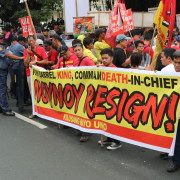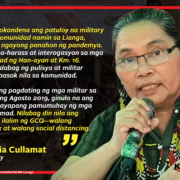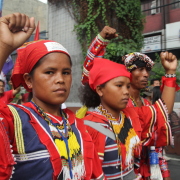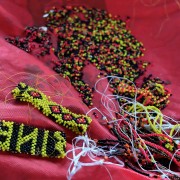STREETWISE: AFP lies won’t bring peace to the lumad by Carol Pagaduan-Araullo
Streetwise
The Armed Forces of the Philippines (AFP) and its most rabid apologists are trying desperately to stem the tide of public outrage here and abroad over the series of killings of unarmed lumad leaders, their supporters and ordinary community members attributed to paramilitary groups created, funded, directed and protected by the AFP. They are resorting to squid tactics, red-baiting and victim blaming which only further entrap them in their own web of lies.
During the Senate investigation into the Lianga, Surigao del Sur massacre last week, Senator Teofisto Guingona III underscored the fact that more than a month since the incident, the alleged perpetrators roam free. There are even reports that they continue to terrorize other lumad communities. As of this writing another lumad leader has been killed in Agusan del Sur.
Testimonies from the provincial governor, religious leaders and representatives of the 3000 lumad who have sought sanctuary in Tandag City, are one in pointing to a paramilitary group, the Magahat-Bagani, composed of AFP recruits from among lumad communities, as the perpetrators. More telling, they accuse the AFP of coddling the killers and are calling for the dismantling of these groups.
At first, the AFP tried to sell the idea that the New People’s Army (NPA) was responsible for the killings. It brought several lumad to Manila and presented them in a hastily organized AFP press conference to say that the entire incident was part of a convoluted scheme by the NPA to demonize the military as human rights violators. The AFP insists that the Alternative Learning Center for Agriculture and Livelihood (ALCADEV) is an “NPA school” and the lumad community it serves supports the NPA. The AFP insinuates this is probably why the Magahat-Bagani, whose members are anti-NPA, attacked them.
The AFP claims the military unit that was within striking distance of the rampaging paramilitary group did not intervene because they were trying to “protect” the people by avoiding civilian casualties who may be caught in the cross fire. The AFP complains that it is now being unfairly accused of being behind the killings simply because the affected lumad and their supporters are actually pro-NPA. Nonetheless, the AFP’s proffered explanation — that the NPA killed its own supporters to make the AFP look bad – is just too absurd to be believed by anybody with a grain of independence and an ounce of grey matter.
Consequently the AFP tried to distance itself from the Magahat-Bagani with another incredible line, that these armed groups are “independently organized” and are composed of “traditional” lumad warriors defending their territory from the intrusion of the NPA. The AFP says these are not under its direction and control. Accordingly, since these groups are fighting against lumad who have joined the NPA or support the NPA, the AFP posits some kind of “tribal war” going on. The recent killings are alleged to be a consequence of this internal conflict among the lumad but the AFP denies it has anything to do with this so-called tribal war. Indeed, what the AFP tries to cover up are the origins of these paramilitary groups and how they grew and gained the capacity to terrorize entire lumad communities with impunity.
Their rise can be traced to attempts by big business concerns to exploit the untapped mining, logging and agribusiness potential of lumad areas. The Indigenous People’s Rights Act (IPRA) of 1997, that was supposed to protect the indigenous people from being displaced from their ancestral domain by facilitating the grant of Certificates of Ancestral Domain Titles (CADTs), paved the way for some lumad leaders to treat the ancestral domain as their private property for disposition as they please. These lumad leaders were bribed by the corporations to agree to open lumad lands for exploitation.
However other leaders resisted, realizing that the promised “development” would destroy the forests, the rivers, the land and the lumad way of life. The ensuing conflict turned very violent as those who favored the entry of the corporations were backed by these corporations and were armed by the military. Those who opposed became the targets of harassment, forced agreement and outright murder. Some of them took up arms and eventually joined the NPA operating in their areas. The people welcomed the NPA’s presence to defend them from the AFP, the security forces of the corporations and the paramilitary lumad groups that were given arms, funding and protection by the AFP.
At the root of the conflict is the lumad’s defense of their ancestral domain from wanton exploitation. It is also entwined with their assertion of their right to determine the kind of development that will genuinely uplift their socio-economic situation even as their traditions and culture are respected and nurtured. It is thus understandable that the ranks of the NPA in Mindanao include lumad. The mountainous areas where the lumad have been forced to retreat by the encroachment of lowlanders are also the areas where the NPA are strongest.
The government says the NPA is already a “spent force”. So how does the NPA survive and – in some areas, according even to the AFP, expand their influence – if they are not being supported voluntarily by the people, like the lumad of Mindanao? If the NPA has sufficient mass support to be able to sustain what has been dubbed as “the longest running communist insurgency in the world” how can the military defeat it without resorting to a bloody, brutal, no-holds-barred war against these supporters, including the lumad?
Some peace advocates suggest that the solution to the violence is to withdraw the AFP, paramilitary and NPA from the lumad areas and declare these as zones of peace. At first glance, this sounds logical and fair. But a closer look will show it won’t work because it does not address the real issues and consequently draws away from the real solution. One only has to ask in the first instance — will the mining corporations then be free to operate in these areas and do as they wish or will? Will they be allowed to have their own security guards? If so, would these be non-lumad but armed? Or lumad but unarmed? Will the lumad benefit from this more than the corporations? And finally, what mechanism, action or process could make the AFP and NPA both agree to withdraw from any area, or even to stop firing their weapons at each other? Certainly, not mere calls, appeals or exhortations.
In the final analysis, the peaceful resolution of armed conflict in lumad and non-lumad areas in Mindanao and the rest of the country can only be brought about by the resumption of peace negotiations between the Philippine government and the National Democratic Front of the Philippines (the umbrella formation for the CPP-NPA and other revolutionary forces waging an armed struggle).
Such peace talks must address the root causes of armed conflict and must proceed on the basis of the previous bilateral agreements, without preconditions. Meanwhile, mitigation of the most grievous effects of the armed conflict can already be addressed by implementing the Comprehensive Agreement on Respect for Human Rights and International humanitarian law (CARHRIHL) through the operationalization of the Joint GPH-NDFP Monitoring Committee. The latter receives and investigates complaints lodged by victims and either Party to the agreement.
Peace advocates of whatever ideological and political persuasion should seize the issue of lumad killings as an opening to even more determinedly push for peace talks to resume and go forward to negotiations over socio-economic reforms, political and constitutional reforms, and finally, the end of hostilities and disposition of forces.
True peace must be based on justice and not be the peace of the graveyard. #
Published in Business World
5 October 2015







